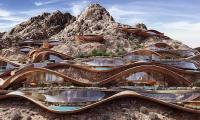The worst floods in the history of Pakistan have taken more than one thousand lives and displaced millions. Most of the victims are poor and destitute, living in makeshift shelters, at sub sustenance level.
Poverty has compounded the misery many times over. Free market based economic system has resulted in concentration of wealth and worsening of inequality. To move towards a more egalitarian system requires some structural changes challenging the entrenched vested interests. But who will bell the cat?
The talk is mostly focused on relief and rehabilitation but no one is talking about poverty and environmental degradation which are closely intertwined. Both are at the root of this disaster. In fact, most disasters just like poverty are made by humans. The poor are forced to settle in river beds or ‘nullahs’ because the state has abdicated its responsibility of providing housing for all. This causes water flow problems. The dilapidated infrastructure adds to the disaster.
Sixty-nine per cent of Pakistan’s population is dependent on wood burning for its daily energy needs; and the timber mafia, which acts with impunity, is also causing rapid deforestation of Pakistan. Out of the $1.81 trillion global underground economy, $7 billion includes illegal logging. Pakistan’s share in this is $782 million.
About 500,000 workers are employed in forestry and related industries. Pakistan loses 39 hectares of forest land annually. This puts the livelihood of all these people at risk. According to the World Wildlife Fund, only 5.7 per cent of land is under forest cover in Pakistan whereas the recommended cover area is 25 per cent. Pakistan’s deforestation rate is only second to Afghanistan in Asia. A very sad and scary situation.
Trees facilitate absorption of water into ground, raising underground water levels which are then available for human consumption after the rains are over, rather than being wasted. Heavy rain in the absence of trees can cause landslides, causing heavy losses, especially in mountainous areas.
In 2018, Pakistan was ranked the fifth most vulnerable country for long-term climate change effects on the Global Climate Risk Index. In 2017, Pakistan passed a Climate Change Act, resulting in setting up a Climate Change Council, Climate Change Authority and Climate Change Fund. There is also a Pakistan Environmental Protection Agency. It is hard to say what practical steps have been taken by this bureaucratic structure.
Global factors are beyond our reach but local factors, if addressed, will mitigate if not avert future such disasters. It cannot be overstated that the most important factor is land use. Pakistan does not have any comprehensive land use policy. We have unchecked, unregulated, environmentally hazardous construction with poor engineering standards, housing societies and buildings causing obstruction to the flow of water.
There is a need to develop a policy framework to ensure improved forest management. An extensive public education campaign about environmental issues should be started without further delay. Illegal logging needs to stop. Afforestation should be pursued aggressively. A comprehensive land use policy should be developed keeping in mind environmental considerations as well as the public’s food, housing and other needs. Construction also has to be regulated to ensure water flow is unhindered. We need to find innovative solutions to conserve and store excess water during the rainy season. Mega dams have been shown to be environmentally disastrous so not recommended anymore.
Effective disaster management can reduce loss and misery during floods. We can learn something from Bangladesh where 33 per cent of the population faces high climate exposure compared to the six per cent global rate. With early warnings, a network of cyclone shelters and an efficient disaster management system, mortality due to cyclones was reduced from 500,000 in 1970 to 4,234 in 2007.
The question is why we have failed to take any effective measures to prevent and mitigate such disasters. Why do people continue to suffer? Why is the poverty level increasing instead of diminishing? The simple answer is because of poor political decision-making which is based on vested interests and is in the hands of a class of people whose lives are far removed from the life of the average person.
So, then the final question is the same which Lenin posed over a century ago: What is to be done? The answer remains the same. To unite and organize the working class which includes lower layers of the middle class. However, the practical implementation of this is still difficult. Global capital is much stronger. Geopolitics is more complex. The state is oppressive. Rulers use divide and rule tactics just as before. Means of communication, though much more effective, are still not as easily accessible without money and power. The media plays a major role but it is mostly captive to capitalist interests.
Only a grassroots awakening to hold the ruling class accountable and an organized effort to become part of the decision-making class has the potential to rectify the political decision-making process. Oppressive poverty and exploitation of people along with lack of political consciousness and extensive use of money in the electoral process has led to the exclusion and alienation of common citizens from the political process.
Politics is based on personality, clan, tribe or some other loyalties, never on a broader vision like, what kind of education, healthcare, transport system do we want? What are the responsibilities of the state? What roles should the state have in the economy, job creation, energy, internet and provision of other basic necessities to people? Lastly, there is almost a complete lack of a culture of ‘collective action for collective good’. Most people are just content in striving to solve their individual problems. Many accept it as their fate and keep waiting for a miracle. So, currently there is no one who can bell the cat.
The writer is the vice chairperson of Barabri Party Pakistan. She can be reached at: shahnazK@gmail.com
A worker fixes a flag of the ruling Bharatiya Janata Party on a hoarding of their leader and India’s Prime Minister...
Prime Minister Shehbaz Sharif and Foreign Minister Ishaq Dar address a press conference in Lahore. — AFP/FileWhen...
Koohi Goth Women Hospital in Malir Karachi. — Facebook/koohigoth1A majority of poor women in Pakistan have a faint...
This image shows Pakistan's Ayesha Rashid, who was recently given the heart of a 69-year-old brain-dead Indian patient...
A car is seen burning along a road as Pakistan Tehreek-e-Insaf party activists and supporters of former prime...
Students of the Church Mission School, located in the heart of Karachi’s old city area, brief a judge about the...







